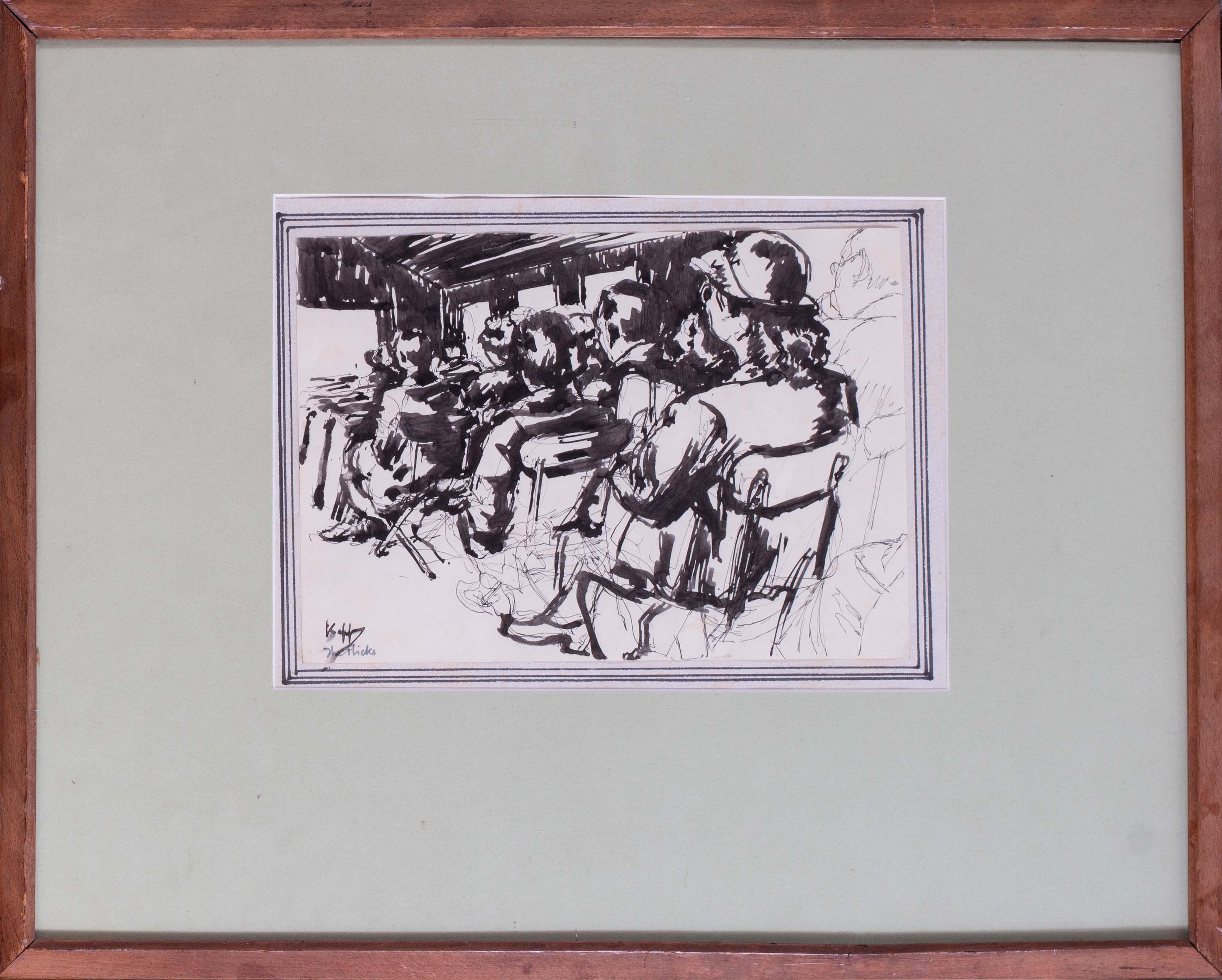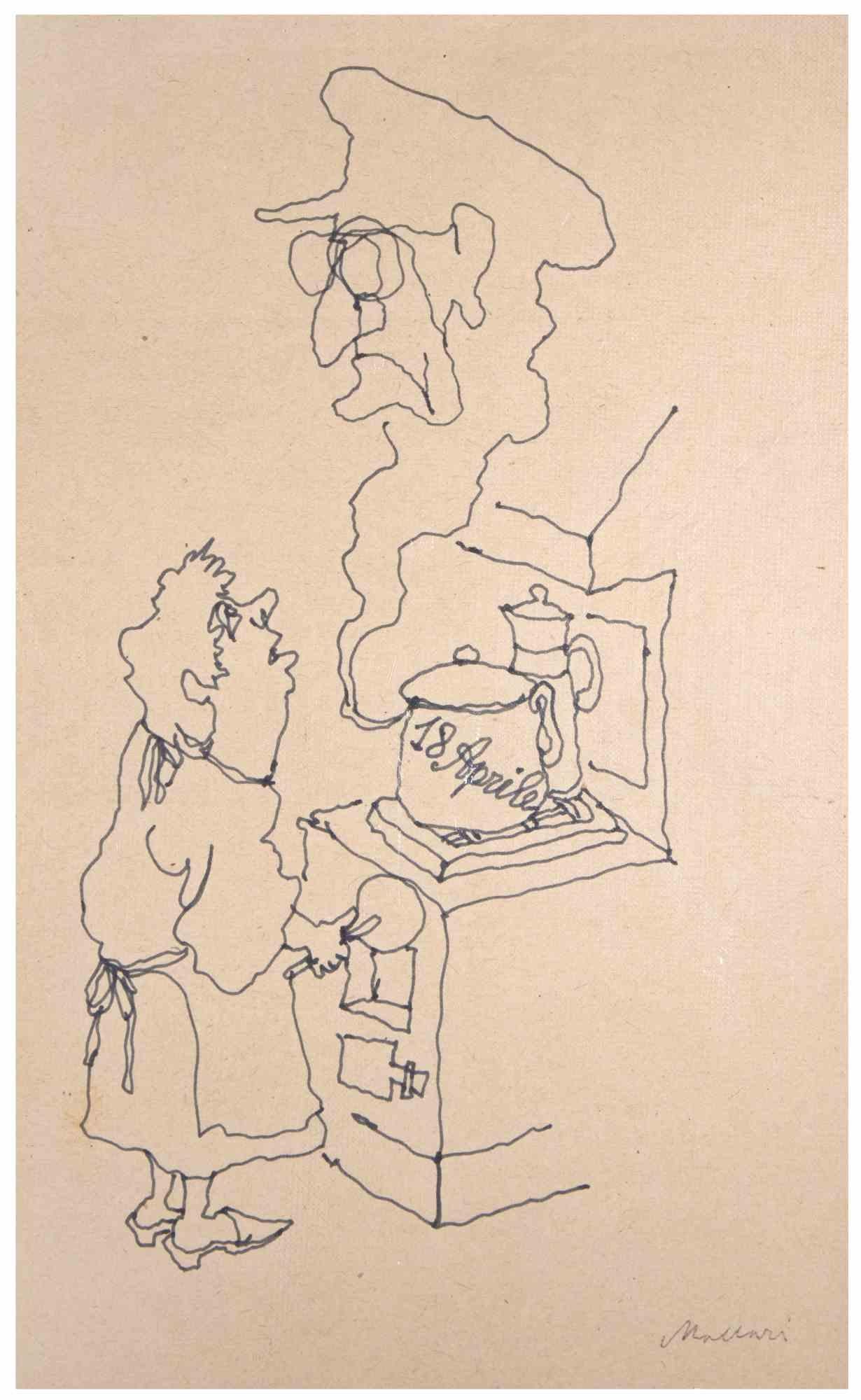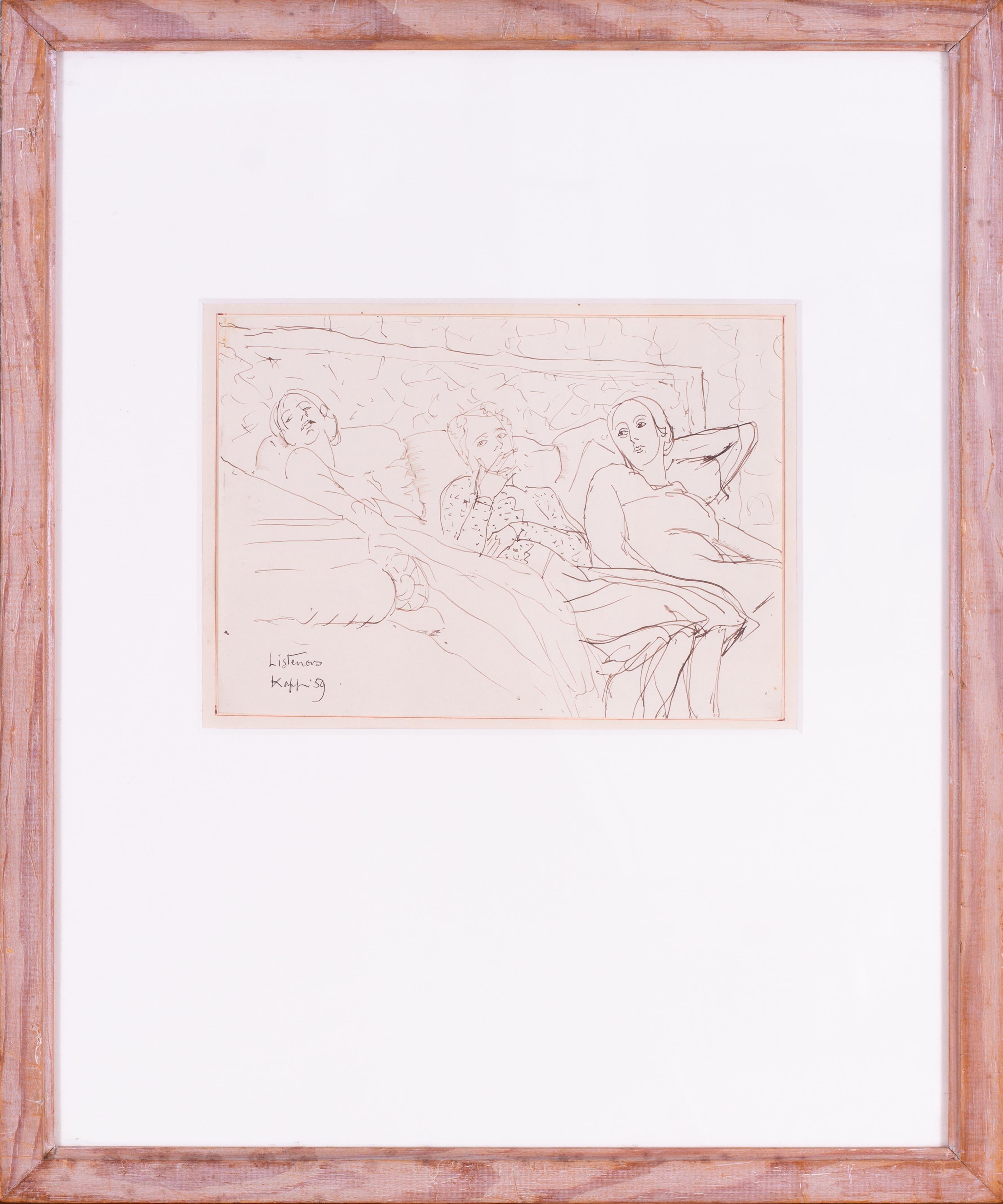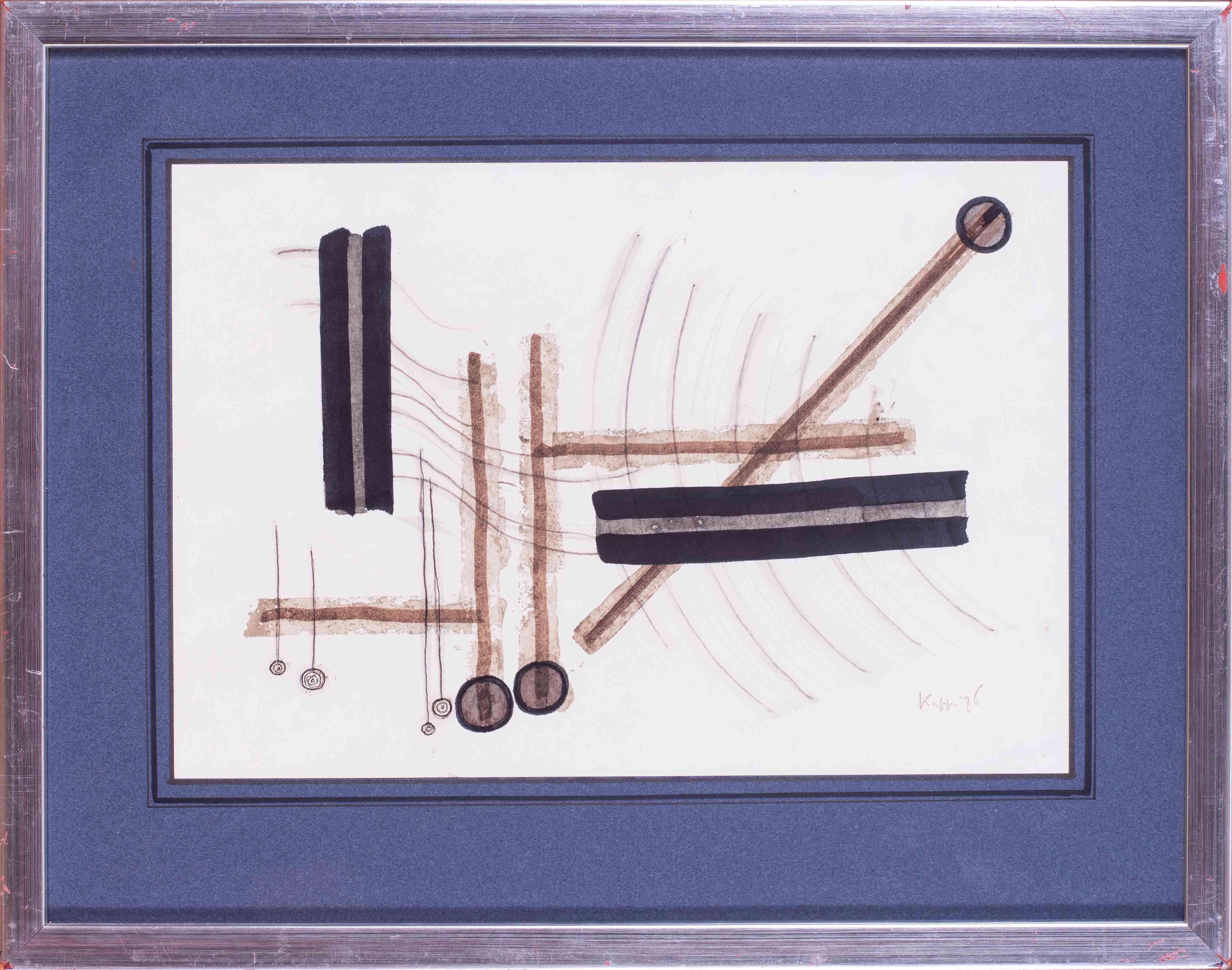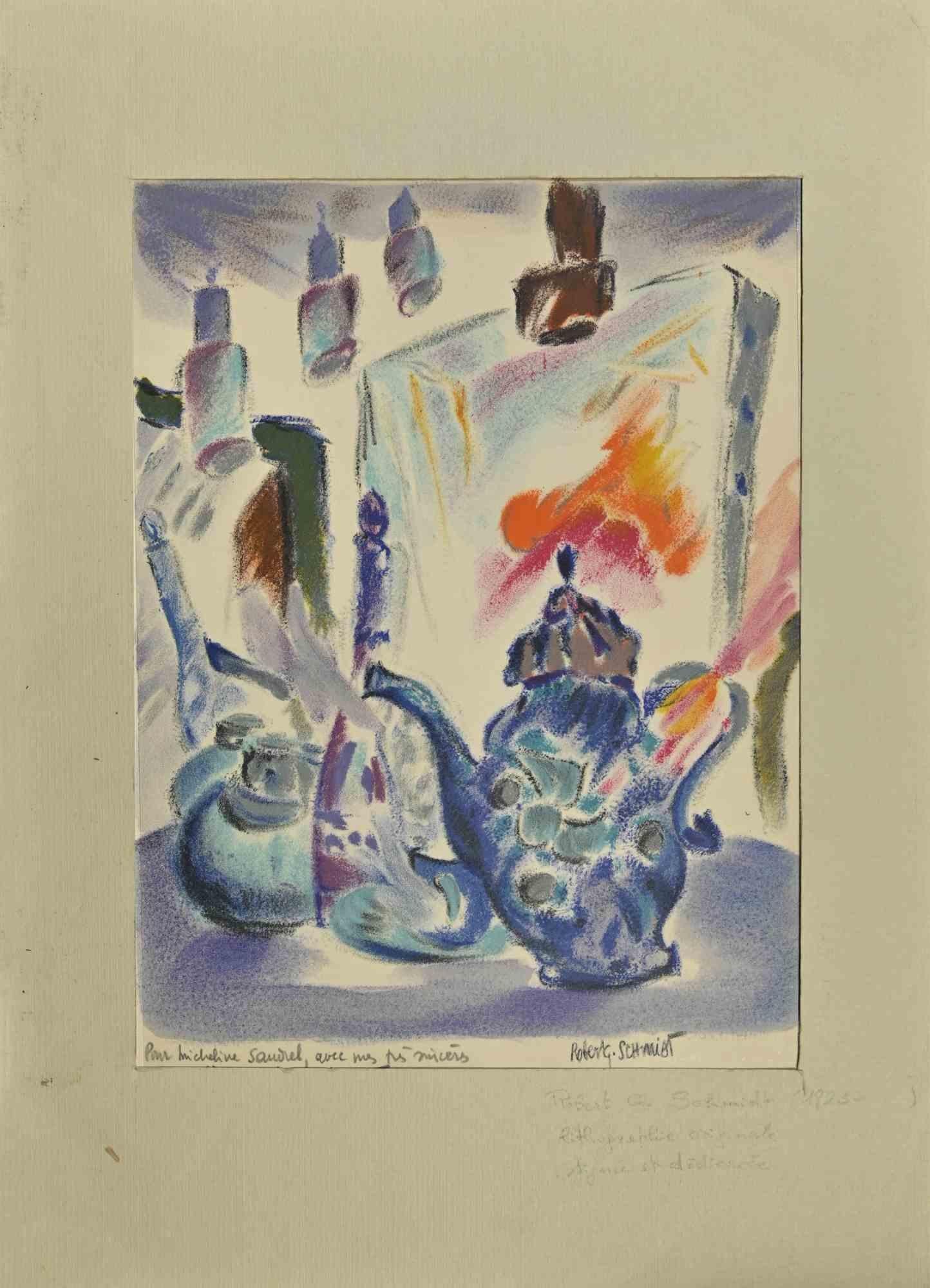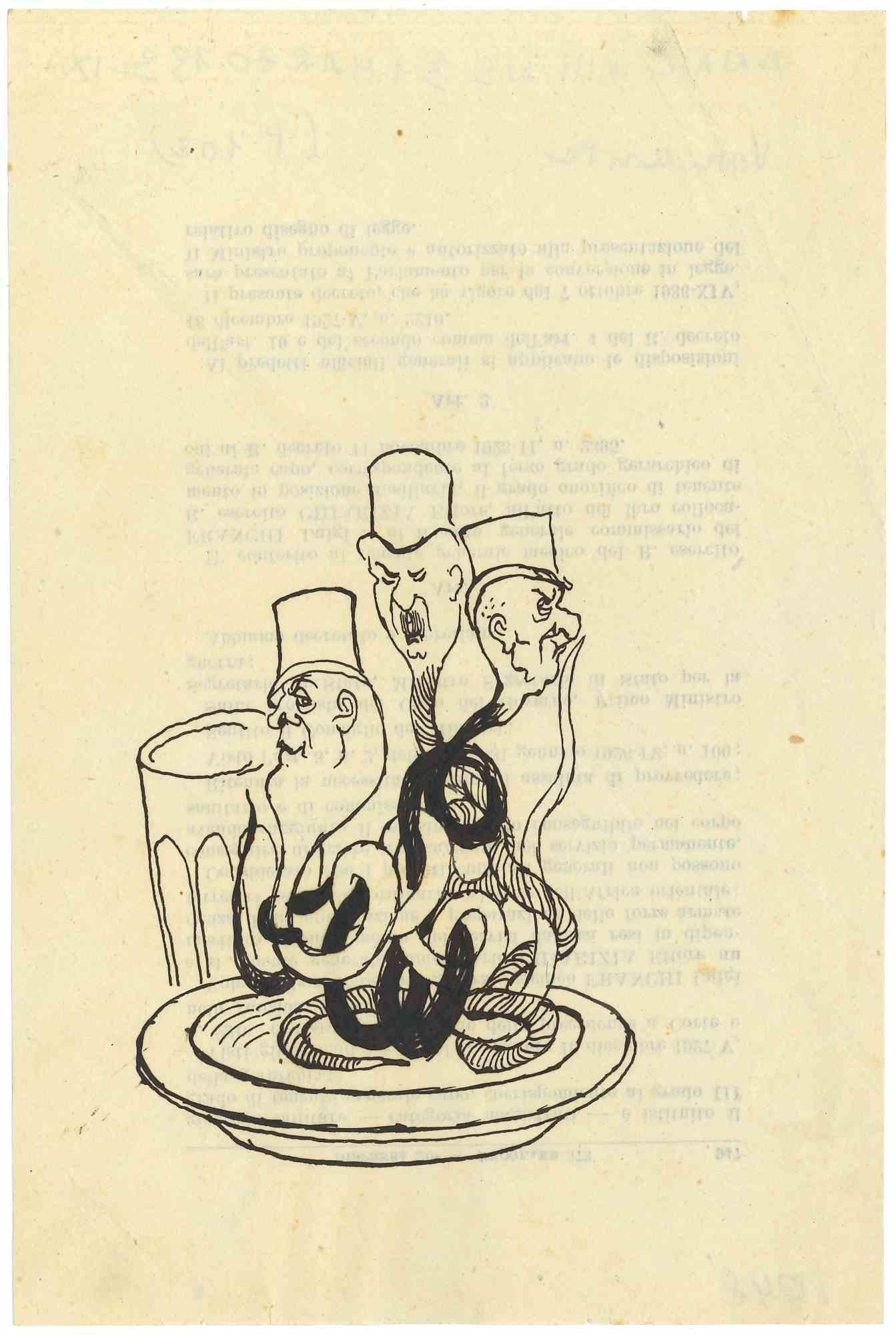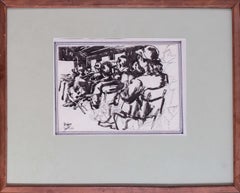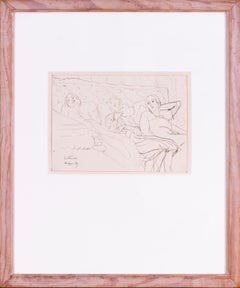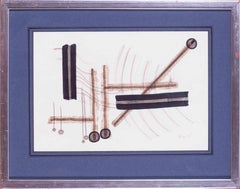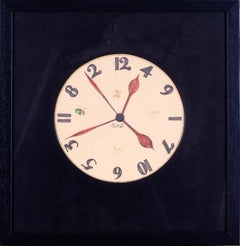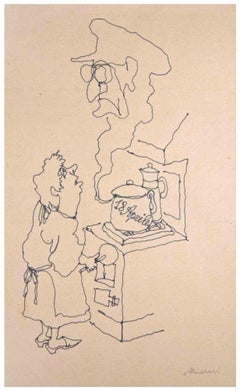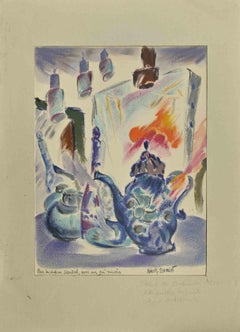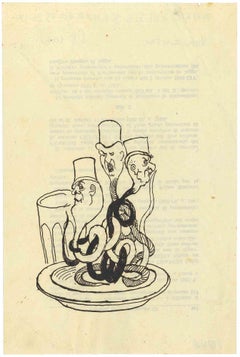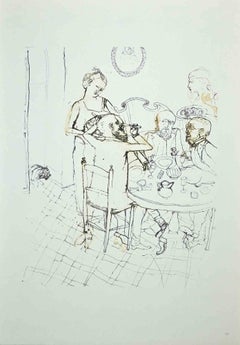Items Similar to Mid Century Modern British 'Hot Soup' by British German illustrator Kapp, 1938
Want more images or videos?
Request additional images or videos from the seller
1 of 7
Edmond Xavier KappMid Century Modern British 'Hot Soup' by British German illustrator Kapp, 19381938
1938
$758.81
£550
€648.82
CA$1,043.74
A$1,160.18
CHF 608.14
MX$14,168.56
NOK 7,592.27
SEK 7,142.91
DKK 4,842.63
About the Item
Eduard Xavier Kapp (British, 1890 – 1978)
Hot soup
Pen on paper
Inscribed and dated ‘Hot Soup / 15-12-38’ (upper right) and signed ‘kapp’ (lower right)
7.1/2 x 12.3/8 in. (19 x 31.5 cm.)
Edmond Kapp was born in Islington, London, on 5 November 1890, of American and German Jewish parentage. He gave himself the middle initial ‘X’ – sometimes said to stand for Xavier – to distinguish himself from his father Emil Kapp, who was a wine merchant. However, his parents called him ‘Eddie’ while his wife and friends knew him as ‘Peter’.
During his early years, Kapp was continually ill and, while convalescing, entertained himself by drawing at home. As his health improved, he attended Dame Alice Owen’s School, Islington (1903-10), with periods at Berlin University (1909) and L’Institut Français pour les Etrangers, Paris (1909). He then read Languages at Christ’s College, Cambridge (1910-13), though spent most of his time writing and drawing.
Kapp took a studio in London, and worked intensively until the outbreak of the First World War, contributing to the Daily News, the Onlooker and other periodicals. During the war, he served as a 2nd Lieutenant in the Royal Sussex Regiment on the Western Front, and then in Intelligence, rising to the position of Staff Captain on Haig’s Staff. Finally, he founded and directed the Neutral Press Counter-propaganda Section.
In 1919, Kapp returned to London and, after abortive periods at three art schools, worked alone. In that year, he made his name with an exhibition of caricatures, held at Furst’s Gallery, London, and accompanied by a catalogue introduced by Max Beerbohm. This soon led to contracts with three London periodicals and a book of caricatures, Personalities, published by Martin Secker. Through the 1920s and 30s, his drawings of musicians and other personalities appeared in a wide variety of periodicals, most notably Time & Tide; were collected in further volumes; and were exhibited at the Leicester Galleries. He considered himself to be a ‘character-portraitist’, producing images of psychological not satirical power, and disliking the term ‘caricature’.
Between the wars, Kapp developed other aspects of his artistic talents, the desire to study and the search for subject matter often taking him abroad. For instance, work at the British Academy, Rome, under Antonio Sciortino, and with the American painter, Maurice Sterne, led him to produce his first oils (1923); while an introduction to the League of Nations in Geneva allowed him to use his new-found skill in lithography to produce portraits of twenty-five of its members (1933-35). This expansive and exploratory attitude to his work resulted in an increase in patrons and exhibitions, and in important artistic friendships, notably with Picasso (Picasso sat for Kapp in 1938).
Kapp worked as an Official War Artist during the Second World War, and then as an Official Artist to UNESCO. In the post-war period, he had a studio in Beausoleil, Alpes Maritimes, and explored abstract painting ‘passionately, though without dogmatism’ (Edmond Kapp, London: Whitechapel Art Gallery, 1961, page 8).
Kapp died on 29 October 1978. His sister – the artist Helen Kapp – had died earlier in the same month. The first of his three wives was Yvonne Kapp, biographer of Eleanor Marx and author of the memoir, Time Will Tell. They had visited Beerbohm in Rapallo during their honeymoon in 1923.
His work is represented in numerous public collections, including the National Portrait Gallery; The Barber Institute of Fine Arts (University of Birmingham), the Fitzwilliam Museum (Cambridge) and Manchester Art Gallery; and Albright-Knox Art Gallery (Buffalo).
- Creator:Edmond Xavier Kapp (1890 - 1978, British)
- Creation Year:1938
- Dimensions:Height: 7.5 in (19.05 cm)Width: 12.38 in (31.45 cm)Depth: 1 in (2.54 cm)
- Medium:
- Movement & Style:
- Period:
- Condition:Paper laid on a pink ground with artist’s pen lines, and further laid down on a cream sheet of card, minor surface dirt and foxing, further inscribed ‘HOT Soup’ (lower left of card), behind glass in a white frame.
- Gallery Location:Petworth, GB
- Reference Number:1stDibs: LU540313641472
About the Seller
4.9
Platinum Seller
Premium sellers with a 4.7+ rating and 24-hour response times
Established in 2010
1stDibs seller since 2017
272 sales on 1stDibs
Typical response time: 3 hours
- ShippingRetrieving quote...Shipping from: Petworth, United Kingdom
- Return Policy
Authenticity Guarantee
In the unlikely event there’s an issue with an item’s authenticity, contact us within 1 year for a full refund. DetailsMoney-Back Guarantee
If your item is not as described, is damaged in transit, or does not arrive, contact us within 7 days for a full refund. Details24-Hour Cancellation
You have a 24-hour grace period in which to reconsider your purchase, with no questions asked.Vetted Professional Sellers
Our world-class sellers must adhere to strict standards for service and quality, maintaining the integrity of our listings.Price-Match Guarantee
If you find that a seller listed the same item for a lower price elsewhere, we’ll match it.Trusted Global Delivery
Our best-in-class carrier network provides specialized shipping options worldwide, including custom delivery.More From This Seller
View AllMid Century Modern British 'The Flicks' by British German illustrator Kapp
Located in Petworth, West Sussex
Edmond Xavier Kapp (British, 1890 – 1978)
The Flicks
Ink on paper
Signed and inscribed ‘Kapp The Flicks’ (Lower left)
8.3/8 x 12.7/8 in. (21.2 x 30.1 cm.)
Provenance: From the estate...
Category
Mid-20th Century Modern Figurative Drawings and Watercolors
Materials
Paper, Ink
Mid Century Modern British 'Listeners' by British German illustrator Kapp, 1959
Located in Petworth, West Sussex
Edmond Xavier Kapp (British, 1890 – 1978)
Listeners
Inkpen
Signed, inscribed and date ‘Listeners / Kapp 59’ (lower left)
7.5/8 x 10.1/2 in. (19.4 x 26.7 cm.)
Edmond Kapp was born in Islington, London, on 5 November 1890, of American and German Jewish parentage. He gave himself the middle initial ‘X’ – sometimes said to stand for Xavier – to distinguish himself from his father Emil Kapp, who was a wine merchant. However, his parents called him ‘Eddie’ while his wife and friends knew him as ‘Peter’.
During his early years, Kapp was continually ill and, while convalescing, entertained himself by drawing at home. As his health improved, he attended Dame Alice Owen’s School, Islington (1903-10), with periods at Berlin University (1909) and L’Institut Français pour les Etrangers, Paris (1909). He then read Languages at Christ’s College, Cambridge (1910-13), though spent most of his time writing and drawing.
Kapp took a studio in London, and worked intensively until the outbreak of the First World War, contributing to the Daily News, the Onlooker and other periodicals. During the war, he served as a 2nd Lieutenant in the Royal Sussex Regiment on the Western Front, and then in Intelligence, rising to the position of Staff Captain on Haig’s Staff. Finally, he founded and directed the Neutral Press Counter-propaganda Section.
In 1919, Kapp returned to London and, after abortive periods at three art schools, worked alone. In that year, he made his name with an exhibition of caricatures, held at Furst’s Gallery, London, and accompanied by a catalogue introduced by Max Beerbohm. This soon led to contracts with three London periodicals and a book of caricatures, Personalities, published by Martin Secker. Through the 1920s and 30s, his drawings of musicians and other personalities appeared in a wide variety of periodicals, most notably Time & Tide; were collected in further volumes; and were exhibited at the Leicester Galleries. He considered himself to be a ‘character-portraitist’, producing images of psychological not satirical power, and disliking the term ‘caricature’.
Between the wars, Kapp developed other aspects of his artistic talents, the desire to study and the search for subject matter often taking him abroad. For instance, work at the British Academy, Rome, under Antonio Sciortino...
Category
Mid-20th Century Modern Figurative Drawings and Watercolors
Materials
Paper, Ink
Mid Century Modern British 'Toccata 23' by British German illustrator Kapp, 1976
Located in Petworth, West Sussex
Edmond Xavier Kapp (British, 1890 – 1978)
Toccata 23
Ink on paper
Signed and dated ‘Kapp 76’ (lower right)
9.1/2 x 14 in. (24.3 x 35.5 cm.)
Edmond Kapp was born in Islington, London, on 5 November 1890, of American and German Jewish parentage. He gave himself the middle initial ‘X’ – sometimes said to stand for Xavier – to distinguish himself from his father Emil Kapp, who was a wine merchant. However, his parents called him ‘Eddie’ while his wife and friends knew him as ‘Peter’.
During his early years, Kapp was continually ill and, while convalescing, entertained himself by drawing at home. As his health improved, he attended Dame Alice Owen’s School, Islington (1903-10), with periods at Berlin University (1909) and L’Institut Français pour les Etrangers, Paris (1909). He then read Languages at Christ’s College, Cambridge (1910-13), though spent most of his time writing and drawing.
Kapp took a studio in London, and worked intensively until the outbreak of the First World War, contributing to the Daily News, the Onlooker and other periodicals. During the war, he served as a 2nd Lieutenant in the Royal Sussex Regiment on the Western Front, and then in Intelligence, rising to the position of Staff Captain on Haig’s Staff. Finally, he founded and directed the Neutral Press Counter-propaganda Section.
In 1919, Kapp returned to London and, after abortive periods at three art schools, worked alone. In that year, he made his name with an exhibition of caricatures, held at Furst’s Gallery, London, and accompanied by a catalogue introduced by Max Beerbohm. This soon led to contracts with three London periodicals and a book of caricatures, Personalities, published by Martin Secker. Through the 1920s and 30s, his drawings of musicians and other personalities appeared in a wide variety of periodicals, most notably Time & Tide; were collected in further volumes; and were exhibited at the Leicester Galleries. He considered himself to be a ‘character-portraitist’, producing images of psychological not satirical power, and disliking the term ‘caricature’.
Between the wars, Kapp developed other aspects of his artistic talents, the desire to study and the search for subject matter often taking him abroad. For instance, work at the British Academy, Rome, under Antonio Sciortino...
Category
Mid-20th Century Modern Abstract Drawings and Watercolors
Materials
Paper, Ink
Mid Century Modern British 'What's the Time?' by British German Kapp, 1975
Located in Petworth, West Sussex
Eduard Xavier Kapp (British, 1890 – 1978)
What’s the Time?
Pen and crayon, tondo
Signed and dated ‘Kapp 75’ (in the centre)
8.1/2 x 8.1/2 in. (21.6 x 21.6 cm.)
Edmond Kapp was born in Islington, London, on 5 November 1890, of American and German Jewish parentage. He gave himself the middle initial ‘X’ – sometimes said to stand for Xavier – to distinguish himself from his father Emil Kapp, who was a wine merchant. However, his parents called him ‘Eddie’ while his wife and friends knew him as ‘Peter’.
During his early years, Kapp was continually ill and, while convalescing, entertained himself by drawing at home. As his health improved, he attended Dame Alice Owen’s School, Islington (1903-10), with periods at Berlin University (1909) and L’Institut Français pour les Etrangers, Paris (1909). He then read Languages at Christ’s College, Cambridge (1910-13), though spent most of his time writing and drawing.
Kapp took a studio in London, and worked intensively until the outbreak of the First World War, contributing to the Daily News, the Onlooker and other periodicals. During the war, he served as a 2nd Lieutenant in the Royal Sussex Regiment on the Western Front, and then in Intelligence, rising to the position of Staff Captain on Haig’s Staff. Finally, he founded and directed the Neutral Press Counter-propaganda Section.
In 1919, Kapp returned to London and, after abortive periods at three art schools, worked alone. In that year, he made his name with an exhibition of caricatures, held at Furst’s Gallery, London, and accompanied by a catalogue introduced by Max Beerbohm. This soon led to contracts with three London periodicals and a book of caricatures, Personalities, published by Martin Secker. Through the 1920s and 30s, his drawings of musicians and other personalities appeared in a wide variety of periodicals, most notably Time & Tide; were collected in further volumes; and were exhibited at the Leicester Galleries. He considered himself to be a ‘character-portraitist’, producing images of psychological not satirical power, and disliking the term ‘caricature’.
Between the wars, Kapp developed other aspects of his artistic talents, the desire to study and the search for subject matter often taking him abroad. For instance, work at the British Academy, Rome, under Antonio Sciortino...
Category
Mid-20th Century Modern Still-life Drawings and Watercolors
Materials
Pen
Original mid 20th Century French drawing by Expressionist Morot-Sir 'Graphica'
By Gerard Morot-Sir
Located in Petworth, West Sussex
Gerard Morot-Sir (French, 1931 – 2003)
Graphica
Ink on paper
Signed and dated ‘ Morot-Sir, 59’ (lower left)
12.1/2 x 9.5/8in. (31.7 x 24.5cm.)
Newly framed in a limed wood frame in a...
Category
Mid-20th Century Expressionist Figurative Drawings and Watercolors
Materials
Paper, Ink
Modern British ink pen on paper work of Isaac Stern by Edmond Xavier Kapp
Located in Petworth, West Sussex
Edmond Xavier Kapp (British, 1890 – 1978)
Isaac Stern at work
Inkpen
Signed, inscribed and dated ‘Isaac Stern at work Kapp 51’ (lower right)
17.1/8 x 13.7/8 in. (43.3 x 35.3 cm.)
Edmond Kapp was born in Islington, London, on 5 November 1890, of American and German Jewish parentage. He gave himself the middle initial ‘X’ – sometimes said to stand for Xavier – to distinguish himself from his father Emil Kapp, who was a wine merchant. However, his parents called him ‘Eddie’ while his wife and friends knew him as ‘Peter’.
During his early years, Kapp was continually ill and, while convalescing, entertained himself by drawing at home. As his health improved, he attended Dame Alice Owen’s School, Islington (1903-10), with periods at Berlin University (1909) and L’Institut Français pour les Etrangers, Paris (1909). He then read Languages at Christ’s College, Cambridge (1910-13), though spent most of his time writing and drawing.
Kapp took a studio in London, and worked intensively until the outbreak of the First World War, contributing to the Daily News, the Onlooker and other periodicals. During the war, he served as a 2nd Lieutenant in the Royal Sussex Regiment on the Western Front, and then in Intelligence, rising to the position of Staff Captain on Haig’s Staff. Finally, he founded and directed the Neutral Press Counter-propaganda Section.
In 1919, Kapp returned to London and, after abortive periods at three art schools, worked alone. In that year, he made his name with an exhibition of caricatures, held at Furst’s Gallery, London, and accompanied by a catalogue introduced by Max Beerbohm. This soon led to contracts with three London periodicals and a book of caricatures, Personalities, published by Martin Secker. Through the 1920s and 30s, his drawings of musicians and other personalities appeared in a wide variety of periodicals, most notably Time & Tide; were collected in further volumes; and were exhibited at the Leicester Galleries. He considered himself to be a ‘character-portraitist’, producing images of psychological not satirical power, and disliking the term ‘caricature’.
Between the wars, Kapp developed other aspects of his artistic talents, the desire to study and the search for subject matter often taking him abroad. For instance, work at the British Academy, Rome, under Antonio Sciortino...
Category
20th Century Modern Still-life Drawings and Watercolors
Materials
Paper, Ink
You May Also Like
Appearance - Drawing by Mino Maccari - Mid-20th Century
By Mino Maccari
Located in Roma, IT
Appearance is a china ink drawing artwork realized by Mino Maccari (1924-1989) in the Mid-20th Century.
Hand-signed.
Good conditions with slight foxing.
Mino Maccari (Siena, 1924...
Category
Mid-20th Century Modern Figurative Drawings and Watercolors
Materials
Paper, Pen
Composition - Drawing by Robert Schmidt - Mid-20th Century
Located in Roma, IT
Composition is a drawing realized by Robert Schmidt in the Mid-20th Century.
Oil pastel and watercolor on paper.
Good conditions with slight foxing.
The artwork is realized throug...
Category
Mid-20th Century Modern Figurative Drawings and Watercolors
Materials
Watercolor, Oil
The Spaghetti with Politician Sauce - Drawing by Mino Maccari - Mid-20th Century
By Mino Maccari
Located in Roma, IT
The Spaghetti with Politician Sauce is an original Drawing in pen on paper realized by Mino Maccari in mid 20th century.
Good conditions.
Mino Maccari (1898-1989) was an Italian wr...
Category
Mid-20th Century Modern Figurative Drawings and Watercolors
Materials
Pen
The Dinner - Offset Print by Franco Gentilini - 1970s
By Franco Gentilini
Located in Roma, IT
The Dinner is an original vintage offset print on ivory-colored paper, realized by Franco Gentilini ( Italian Painter, 1909-1981), in 1970s.
The state of preservation of the artwor...
Category
1970s Modern Figurative Prints
Materials
Paper, Offset
Mid-Century French Feutre on Paper. Tea time In the Kitchen.
Located in Cotignac, FR
Late Mid Century French feutre drawing on paper of a Provençal lady sitting in her kitchen by Jean Arène. Signed and dated bottom left.
This artwork is a striking pen-and-ink drawing that vividly captures a cluttered interior scene filled with an assortment of teapots and household objects. The central figure, an elderly lady with an expressive face, sits at a table surrounded by an overwhelming array of details. The artist uses bold, dynamic lines to convey a sense of chaos and charm, creating an atmosphere of cozy clutter. The composition’s intricacy draws the viewer's eye around the room, showcasing...
Category
1960s Expressionist Figurative Drawings and Watercolors
Materials
Paper, Felt Pen
Cooking - Drawing by Mino Maccari - Mid-20th Century
By Mino Maccari
Located in Roma, IT
Cooking is a china ink drawing realized by Mino Maccari (1924-1989) in the Mid-20th Century.
Hand-signed.
Good conditions with slight foxing.
Mino Maccari (Siena, 1924-Rome, June...
Category
Mid-20th Century Modern Figurative Drawings and Watercolors
Materials
Paper, Charcoal
